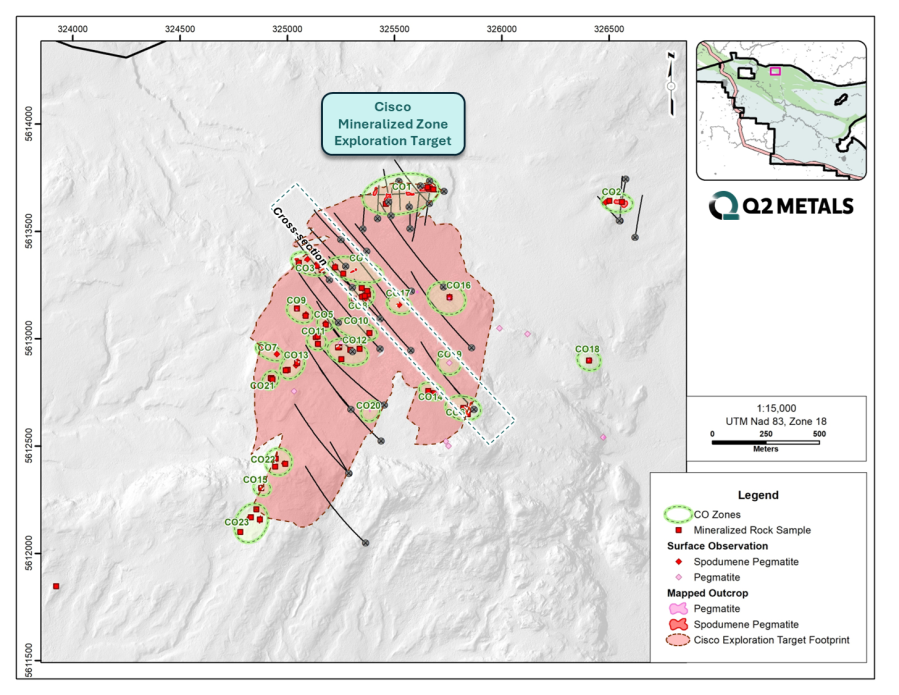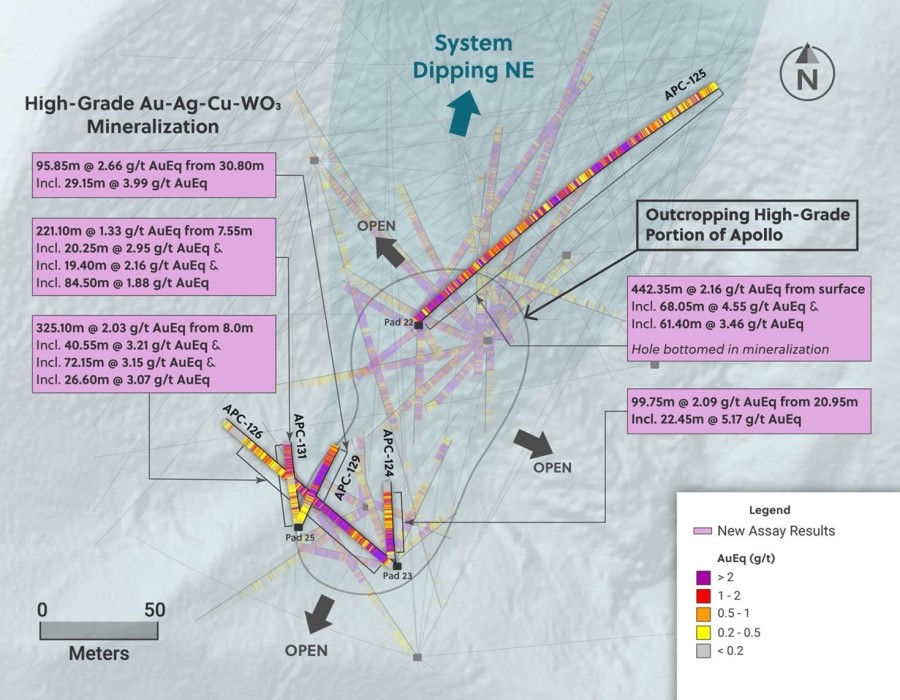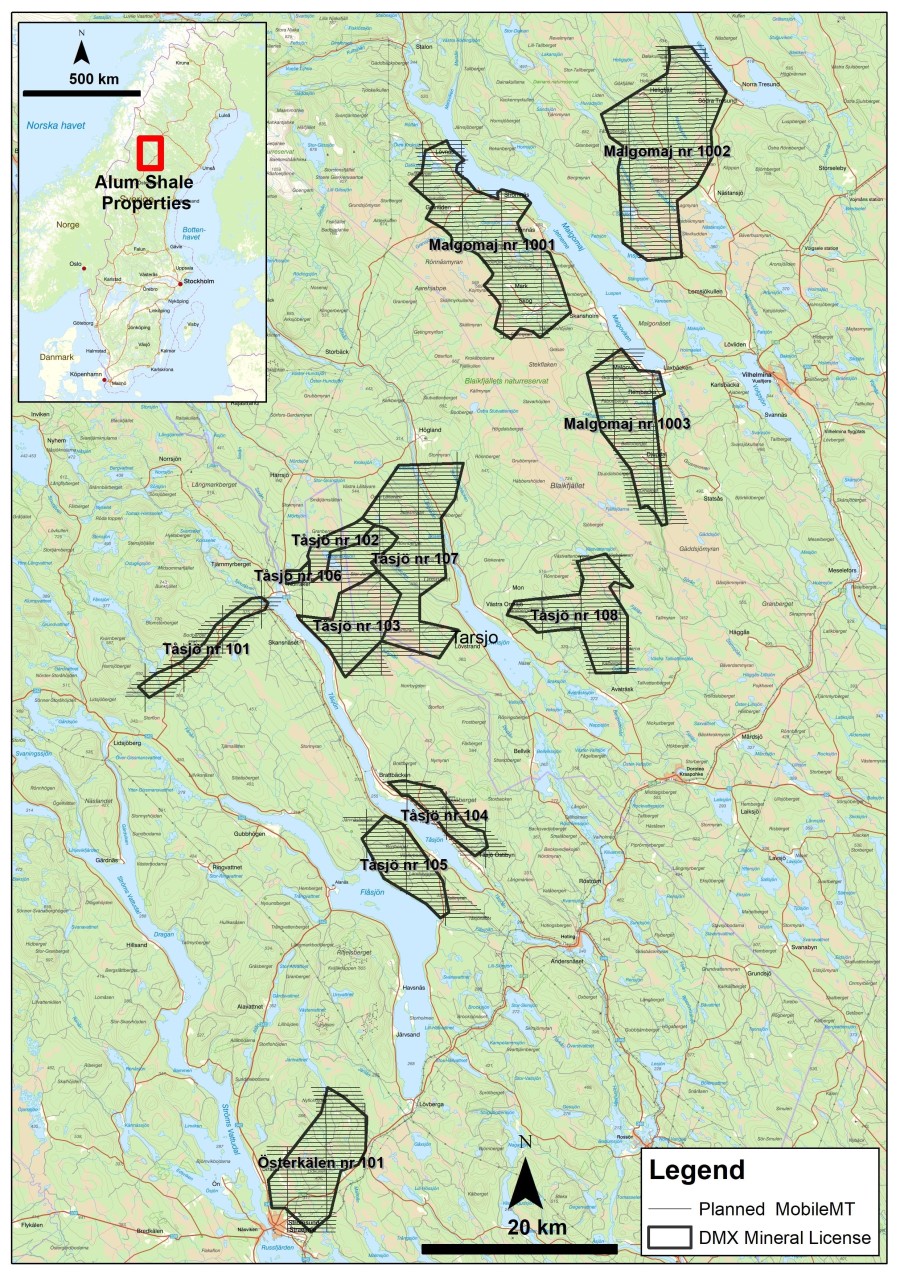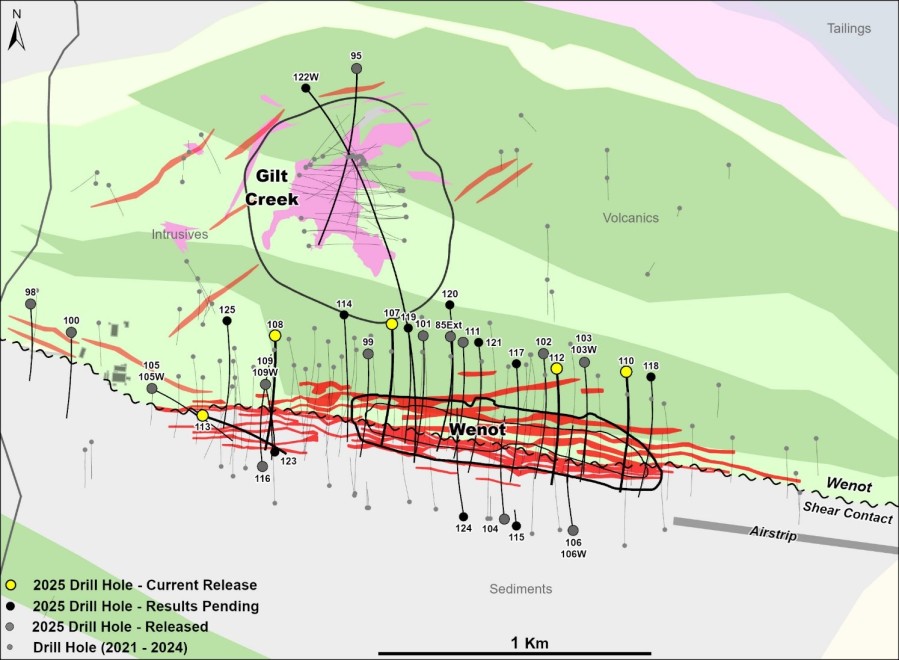Highlights
- The initial Exploration Target estimates a range of lithium mineralization at the Cisco Project from 215 to 329 Mt at a grade ranging from 1.0 to 1.38 % Li2O.
- Based only on the first 40 holes drilled to date.
- Drill testing continues with mineralization open at depth and along strike with potential for significant expansion at the Cisco Mineralized Zone.
- The 2025 Summer Program is ongoing, with rolling assay results anticipated into Q3 2025 as the Company works towards a maiden resource estimate.
- The Exploration Target was completed by BBA Inc., an independent geological and engineering consulting firm, and is based on exploration and drilling to date.
VANCOUVER, British Columbia, July 21, 2025 (GLOBE NEWSWIRE) -- Q2 Metals Corp. (TSX.V: QTWO | OTCQB: QUEXF | FSE: 458) (“Q2” or the “Company”) is pleased to announce an inaugural Exploration Target on the Cisco Lithium Project (the “Project” or the “Cisco Project”), located within the greater Nemaska traditional territory of the Eeyou Istchee James Bay region of Quebec, Canada.
The estimated range of potential mineralization and grade is from 215 to 329 million tonnes (“Mt”) at a grade ranging from 1.0 to 1.38 % Li2O:
| |
Tonnes Range (Mt) | Li2O Range (%) | ||
| Minimum | Maximum | Minimum | Maximum | |
| Exploration Target | 215 | 329 | 1.00 | 1.38 |
Table 1: Exploration Target for Cisco Mineralized Zone
The potential quantity and grade of the Exploration Target are conceptual in nature. There has been insufficient exploration to estimate and define a Mineral Resource, as defined by National Instrument 43-101 Standards of Disclosure for Mineral Project (“NI 43-101”), and it is uncertain if further exploration will result in the target being delineated as a Mineral Resource.
An Exploration Target is used to provide a conceptual estimate of the potential quantity and grade of a mineral deposit, based on known and additional limited geological evidence. It is an early-stage assessment that will help to guide further exploration, but it is not a mineral resource or mineral reserve and should not be treated as such.
The Exploration Target for the Cisco Project encompasses the main mineralized zone (the “Mineralized Zone”) (see Figure 1), which includes a total of 40 holes drilled for 16,167.8 metres (“m”)1.
Figure 1. Cisco Project showing pegmatite outcrop zones in the Exploration Target area
The Exploration Target is constrained to the Mineralized Zone and does not include prospective geology and targets that the Company has identified outside of the Mineralized Zone. As such, there is the potential to further increase the overall lithium endowment of the Cisco Project.
The large and well-mineralized CO2 outcrop which measures approximately 30 m wide by 80 m long has not yet been confirmed with drilling, and other areas to the east and south of the Mineralized Zone, such as CO6 or CO18 are also not included.
Figure 2. Cross section through the Mineralized Zone at Cisco Project
“This Exploration Target represents a major milestone for Q2 and cements Cisco as a globally significant hard rock lithium discovery,” said Alicia Milne, Q2 Metals President and CEO. “Cisco’s location within the James Bay Lithium District, including proximity to the all-season Billy Diamond Highway and, most notably, rail at the nearby town of Matagami, make it an ideal candidate for a development scenario. We are excited to continue to grow and advance the Cisco Project, executing on our strategy to create value for our shareholders.”
“This Exploration Target, particularly its being limited to just the currently defined Mineralized Zone, highlights both the scale potential of the Cisco Project as well as its grade,” said Q2 VP of Exploration, Neil McCallum. “The Mineralized Zone remains open at depth and along strike and with only 40 holes drilled so far, there is potential for significant expansion at the Cisco Project. We are continuing the 2025 summer drill program with infill drilling of the Mineralized Zone in order to update the current Exploration Target to a NI 43-101 compliant inferred Mineral Resource Estimate.”
Figure 3. Cisco Project location
Exploration Target Live Webinar
Q2 Metals will be hosting a live webinar, with Q&A, on Wednesday July 23 at 9:00 am PT | 12:00 pm ET. To register, click here.
Methodology and Determination for the Exploration Target
The Company engaged BBA Inc. (“BBA”) as an independent consultant to review all exploration and drilling conducted to date at the Cisco Project and to complete an Exploration Target, in accordance with NI 43-101.
The Exploration Target is based on BBA’s interpretation of the following geology and mineralization data that has been compiled to date:
- 40 diamond core drill holes completed for 16,167.8 m;
- 7,358 drill hole assay results;
- 156 surface rock chip samples;
- Surface geological mapping and diamond core geological logging;
- Detailed LiDAR surface topography; and
- The estimate includes geological information for the lower half of drill hole 36, and all of drill holes 38 and 39 (does not include pending assays).
BBA methodology included a complete review of the data and 3D modelling to create a conceptual volume of the pegmatite domains within the Mineralized Zone. The pegmatite domains were interpreted where geological information was available with sufficient quantity and quality. To estimate a tonnage, pegmatite specific gravity (“SG”) was used for the pegmatite domains and based on 407 measurements. The average SG of each domain was then applied individually. An associated grade was then applied based on the assay results for each individual domain. The implied tonnage and grade of each volume was then reduced by a factor (confidence factor) to account for the likelihood of each domain being mineralized at a reasonable grade. The grade and tonnage were then further adjusted by an additional factor to be reported as ranges. The estimated tonnages are rounded to the nearest million tonnes and the grade rounded to the nearest 0.01% Li2O.
The 3D modelling of the pegmatite domains was restricted to the Mineralized Zone. The extent of the interpreted pegmatite domains was limited up to 250 m around the relevant geological information (drill hole, channel). The thickness of the interpreted pegmatite domains is representative of the pegmatite intercepts.
The Exploration Target does not include prospective geology and targets that the Company has identified outside of the Mineralized Zone. As such, there is the potential to further increase the overall lithium endowment of the Cisco Project.
Qualified Person
Mr. Todd McCracken, P.Geo., is a Qualified Person as defined by NI 43-101, and member in good standing with the Ordre des Géologues du Québec and with the Professional Geoscientists of Ontario. Mr. McCracken has reviewed and approved the technical information in this news release. Mr. McCracken is Director – Mining & Geology – Central Canada, of BBA Inc. and is independent of the Company. Mr. McCracken does not hold any securities in the Company.
Neil McCallum, B.Sc., P.Geol, a registered permit holder with the Ordre des Géologues du Québec and Qualified Person as defined by NI 43-101 (“QP”) has reviewed and approved the technical information in this news release. Mr. McCallum is a director and the Vice President Exploration for Q2.
ABOUT Q2 METALS CORP.
Q2 Metals is a Canadian mineral exploration company focused on the Cisco Lithium Project located within the greater Nemaska traditional territory of the Eeyou Istchee, James Bay, Quebec, Canada.
The Cisco Project is comprised of 801 claims, totaling 41,253 hectares, with the main mineralized zone just 6.5 km from the Billy Diamond Highway, which transects the Project. The Town of Matagami, rail head of the Canadian National Railway, is approximately 150 km to the south.
The Cisco Project has district-scale potential with an already identified mineralized zone and drill results that include:
- 120.3 metres at 1.72% Li2O (hole CS-24-010);
- 215.6 metres at 1.69% Li2O (hole CS-24-018);
- 347.1 metres at 1.35% Li2O (hole CS-24-021);
- 188.6 metres at 1.56% Li2O (hole CS-24-023); and
- 179.6 metres at 1.66% Li20 (hole CS-25-027) with an additional 58.0 m at 1.75% Li2O; and 91.8 m at 1.81% Li2O.
The 2025 Summer Program is ongoing, with rolling assay results anticipated into Q3 2025.
FOR FURTHER INFORMATION, PLEASE CONTACT:
| Alicia Milne President & CEO This email address is being protected from spambots. You need JavaScript enabled to view it. |
Jason McBride Investor Relations Manager This email address is being protected from spambots. You need JavaScript enabled to view it. |
Chris Ackerman Corporate Development This email address is being protected from spambots. You need JavaScript enabled to view it. |
| Telephone: 1 (800) 482-7560 E-mail: This email address is being protected from spambots. You need JavaScript enabled to view it. |
Follow the Company: Twitter, LinkedIn, Facebook, and Instagram
Sampling, Analytical Methods and QA/QC Protocols
All drilling is conducted using a diamond drill rig with NQ sized core and all drill core samples are shipped to SGS Canada’s preparation facility in Val D’Or, Quebec, for standard sample preparation (code PRP92) which includes drying at 105°C, crushing to 90% passing 2 mm, riffle split 500 g, and pulverize 85% passing 75 microns. The pulps are then shipped by air to SGS Canada’s laboratory in Burnaby, BC, where the samples are homogenized and subsequently analyzed for multi-element (including Li and Ta) using sodium peroxide fusion with ICP-AES/MS finish (code GE_ICM91A50). The reported Li grade will be multiplied by the standard conversion factor of 2.153 which results in an equivalent Li2O grade. Drill core was saw-cut with half-core sent for geochemical analysis and half-core remaining in the box for reference. The same side of the core was sampled to maintain representativeness.
A Quality Assurance / Quality Control (QA/QC) protocol following industry best practices has been incorporated into the sampling program. Measures include the systematic insertion of quartz blanks and certified reference materials (CRMs) into sample batches at a rate of approximately 5% each. Additionally, analysis of pulp-split and reject-split duplicates was completed to assess analytical precision. The QP has verified the QA/QC results of the analytical work.
Forward-Looking Statements
This news release contains forward-looking statements and forward-looking information (collectively, “forward-looking statements”) within the meaning of applicable Canadian legislation. Forward-looking statements are typically identified by words such as: “believes”, “expects”, “anticipates”, “intends”, “estimates”, “plans”, “may”, “should”, “would”, “will”, “potential”, “scheduled” or variations of such words and phrases and similar expressions, which, by their nature, refer to future events or results that may, could, would, might or will occur or be taken or achieved. Accordingly, all statements in this news release that are not purely historical are forward-looking statements and include statements regarding beliefs, plans, expectations and orientations regarding the future including, without limitation, any statements or plans regard the geological prospects of the Company’s properties and the future exploration endeavors of the Company. Although the Company believes the expectations expressed in such forward-looking statements are based on reasonable assumptions, such statements are not guarantees of future performance and actual results or developments may differ materially from those in the forward-looking statements. Forward-looking statements are based on a number of material factors and assumptions.
Forward-looking statements involve known and unknown risks, uncertainties and other factors that may cause actual results to differ materially from those anticipated in such forward-looking statements. The forward-looking statements in this news release speak only as of the date of this news release or as of the date specified in such statement. Forward looking statements in this news release include, but are not limited to, statements with respect to the definition of an Exploration Target at the Company’s Cisco Project, drilling results on the Cisco Project and inferences made therefrom, the preparation of an exploration target on the Cisco Project, the potential scale of the Cisco Project, the focus of the Company’s current and future exploration and drill programs, the scale, scope and location of future exploration and drilling activities, the Company's expectations in connection with the projects and exploration programs being met, the Company’s objectives, goals or future plans, statements, exploration results, potential mineralization, the estimation of mineral resources, exploration and mine development plans, timing of the commencement of operations and estimates of market conditions. Factors that could cause actual results to differ materially from those in forward-looking statements include failure to obtain necessary approvals, variations in ore grade or recovery rates, changes in project parameters as plans continue to be refined, unsuccessful exploration results, changes in project parameters as plans continue to be refined, results of future resource estimates, future metal prices, availability of capital and financing on acceptable terms, reallocation of proposed use of funds, general economic, market or business conditions, risks associated with regulatory changes, defects in title, availability of personnel, materials and equipment on a timely basis, accidents or equipment breakdowns, uninsured risks, delays in receiving government approvals, unanticipated environmental impacts on operations and costs to remedy same. Readers are cautioned that mineral exploration and development of mines is an inherently risky business and accordingly, the actual events may differ materially from those projected in the forward-looking statements. Additional risk factors are discussed in the section entitled “Risk Factors” in the Company’s Management Discussion and Analysis for its recently completed fiscal period, which is available under Company’s SEDAR profile at www.sedarplus.com.
Should one or more of these risks or uncertainties materialize, or should assumptions underlying the forward-looking statements prove incorrect, actual results may vary materially from those described herein as intended, planned, anticipated, believed, estimated or expected. Although the Company has attempted to identify important risks, uncertainties and factors which could cause actual results to differ materially, there may be others that cause results not to be as anticipated, estimated or intended. The Company does not intend, and does not assume any obligation, to update this forward-looking information except as otherwise required by applicable law.
Neither the TSX Venture Exchange nor its Regulation Services Provider (as that term is defined in the policies of the TSX Venture Exchange) accepts responsibility for the adequacy or accuracy of this release.
___________________
1 Summary of Drill and Assay data.






